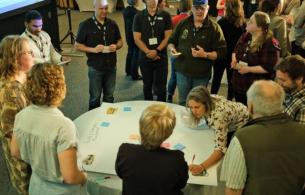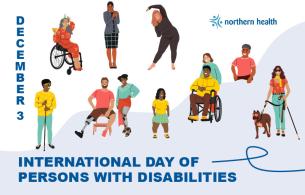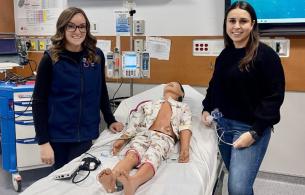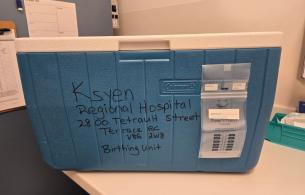October is National Occupational Therapy Month, a time to celebrate the vital role occupational therapists (OTs) and rehabilitation assistants (RAs) play in supporting health and well-being across Northern Health. This month, we're shining a spotlight on two of our own -Micaela Stevenson and Ashleigh Strydom.
Describe your role as occupational therapists in your practice setting?
As occupational therapists on the Inpatient Rehab Unit at UHNBC, we work with clients to help them regain the skills and independence needed to perform activities of daily living. Areas we support can include cognition and visual perception, arm and hand function, learning new strategies for getting dressed or making a meal, and more. We often work with individuals who have sustained a stroke, amputation, or who have lost strength or muscle mass due to prolonged hospital stays. We also provide equipment, including wheelchairs and home safety equipment, for discharge. Our scope on the rehab unit is broad, we focus on function, safety, and quality of life, ensuring clients can manage everyday activities as independently as possible before returning home or moving on to the next stage of care.
What do you enjoy most about your work?
We value having the opportunity to support our clients as they work towards their goals and re-engage in the parts of their days that they find meaningful. It is rewarding to help a client re-learn how to get dressed, independently navigate in their wheelchair, or cook a favorite meal again. With typical rehab unit admissions of 4-8 weeks, we’re able to build strong therapeutic relationships and witness progress and the impact it has on the lives of clients and their families.
How do you collaborate with other health care professionals in your role?
On the rehab unit we work collaboratively with physiotherapists, rehabilitation assistants, social work, speech language pathologists, nurses, and health care assistants to provide client-centered care. As a team, we meet twice weekly to collaborate on goals, care plans, and discharge planning.
Can you share a moment that made you feel especially proud to be an OT?
Ashleigh: One of the most rewarding aspects of working on the rehab unit was the opportunity to incorporate kitchen-based therapy into my clients’ recovery. Cooking engages a wide range of skills, including fine motor, visual-perceptual, attention, memory, and more. This past winter, I had the privilege of supporting an Indigenous client as she returned to the kitchen for the first time since experiencing a stroke. While in the kitchen, she taught me a cherished family recipe for bannock. She later shared the treat with staff and her fellow patients, and as she watched others enjoy eating what she had made, she was moved to tears. This moment made me feel proud to be able to help clients regain independence and reconnect with the parts of life that bring them joy. As an OT, I cherish every small step my clients take towards recovery.
Micaela: Every opportunity we have as OTs to support clients in achieving their goals and enhancing their quality of life is rewarding. One experience that stands out for me is working with a client who had sustained a brain injury, who some team members believed had a poor prognosis for functional recovery. Through strong advocacy, and intensive physical and cognitive rehabilitation, he defied odds and relearned to walk, dress himself, prepare meals, and ultimately return home. His journey was a reminder of not only of the incredible capacity of the human brain to recover, but also of the privilege and responsibility we have as OTs to advocate for our clients and use our unique skillset to support their engagement in activities that matter most to them.
What would you like more people to understand or appreciate about occupational therapy?
We would like more people to learn about the diverse scopes of practice that we can have. OTs work across the lifespan with clients of all ages and abilities. They work in a variety of settings, including hospitals, schools, mental health, community programs, clinics, and clients’ homes. We often encounter preconceptions that OTs work exclusively in return-to-work or hand therapy settings, and we would love for more people to learn about the different setting which OTs can play a role.
For more information on occupational therapy please visit: What is Occupational Therapy? - CAOT














Comments